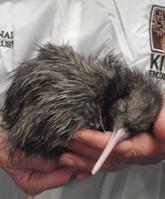Conservationists celebrate new kiwi milestone
Thursday 29 September 2011, 3:01AM
By 100% Pure New Zealand
757 views
A cute little ball of fluff with a long beak has emerged at Rainbow Springs Kiwi Encounter, in Rotorua, to mark another New Zealand conservation milestone.
Yet to be named, the kiwi chick is number 1000 successfully hatched at the Rainbow Springs facility since it joined the BNZ Save the Kiwi conservation programme in 1995.
Conservation staff spent an anxious five days observing the chick’s painstaking progress as it broke out of its shell, emerging at 3.05pm on Saturday (24.09.2011).
An excited tour group was also on hand at the hatchery to see the national icon make its debut appearance.
The little North Island brown kiwi weighed in at a healthy 386.2 grams, which is slightly above average.
Perfect looking chick
Kiwi Encounter husbandry manager Claire Travers said the egg had been transported to the hatchery from Waimarino Forest, near Ohakune in the central North Island.
"It's a perfect looking chick - with rather large feet and a top knot of feathers sticking up on the top of its head which is rather cute."
The chick will spend the next few days resting, drying out and fluffing up its feathers, and getting acquainted with its limbs. It will survive on the egg’s nutritious yolk until it takes a first taste of solid food at around five days.
The new arrival was fathered by kiwi dad Kahu - his 25th egg to come into the hatchery.
Male kiwi are radio-tagged for identification because they are responsible for incubating eggs in the nest. Kiwi mate for life but the female leaves the nest after she has laid the egg.
Caring for kiwi
It is 16 years since the Rainbow Springs team began caring for kiwi eggs brought in by Department of Conservation staff and volunteers under Operation Nest Egg (ONE).
The kiwi eggs are kept safe and warm until they hatch, ensuring the chicks get a good start in life away from predators such as stoats and cats. Once the chicks reach a healthy weight of around 1kg they are returned to the wild.
Kiwi Encounter began the 2011 / 2012 breeding season just over three weeks ago and knowing that there were only 12 hatches to go before reaching the 1000 milestone chick. Last season the facility hatched over 130 kiwi.
"We're very proud to be playing such an important role in the conservation of kiwi. The arrival of the 1000th kiwi at Kiwi Encounter is a great achievement and goes a long way to ensuring the survival of these amazing birds," Ms Travers said.
Endangered kiwi
The kiwi is one of the world’s oddest birds - with mammalian features such as whiskers and hairy feathers, a long sharp beak, big legs and large feet.
The kiwi lays the largest egg in proportion to its size of any species of bird, and evolved for 70 million years before man introduced the mammals that are now their predators.
Eggs and chicks are particularly vulnerable and declining numbers saw the kiwi placed on the endangered species list, and leading to the establishment of breeding programmes such as Operation Nest Egg (ONE) which is sponsored by the Bank of New Zealand.
Background: BNZ Operation Nest Egg
The ONE programme cares for kiwi eggs harvested from nests in the wild where they would be at the mercy of predators.
The kiwi eggs are incubated and hatched, and the chicks reared in captivity until they are big enough to be released back into the wild. Birds raised this way have a 65% chance of surviving their first year of life.
Only 5% of kiwi hatched in the wild reach adulthood, and 20% survival is needed for a population to grow. Operation Nest Egg has so far increased the chances of a kiwi making it to adulthood by seven times.
Young kiwi are returned to the wild when they weigh about 1kg, big enough to fight off predators.
More than 1600 kiwi chicks have been repatriated since the ONE programme began in 1994, with wildlife facilities and hundreds of DOC field workers and community volunteers contributing to the success.
Background: Rainbow Springs
Rainbow Springs Kiwi Wildlife Park - a 22-acre park with a natural fresh water spring - has been a popular kiwi viewing destination since 1932.
The park became involved in kiwi conservation in 1995 with the arrival of an orphaned egg, and the hatchery is now the largest kiwi hatching facility in New Zealand. Eggs are harvested in 13 areas around the North Island where brown kiwi are found.
The park is open for day and night experiences including evening strolls and a hosted dinner activity. Clever night time lighting enhances the evening experience.
Visitors can view adult birds foraging and feeding in a purpose-built nocturnal Kiwi House, or see conservation work in progress and learn more about the iconic bird in the Kiwi Encounter hatchery and nursery.
More information
Bird conservation in New Zealand
